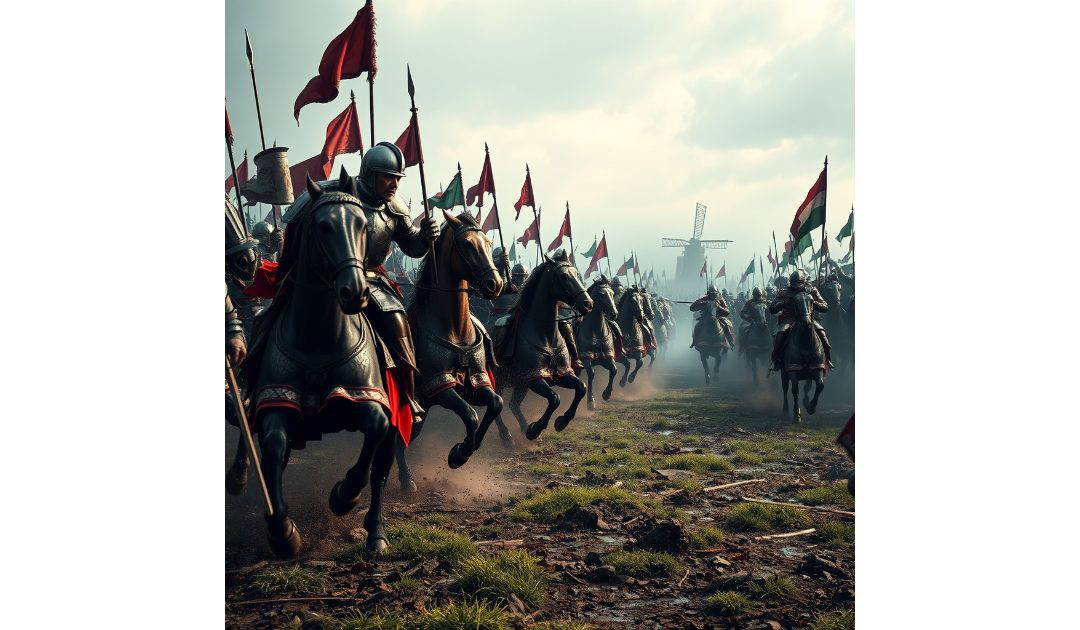The Battle of Oosterweel was fought on the 13th of March, 1567, and marked the outbreak of the Eighty Years’ War, which ultimately led to the independence of the Dutch Republic from Spanish rule. My ancestor, the Elizabethan spy Sir Anthony Standen, was caught up in the Eighty Years War and met William of Orange, as told in The Spy who Sank the Armada, the first book in the Sir Anthony Standen Adventures. This initial battle took place near Antwerp, in the Spanish Netherlands (modern-day Belgium), and marked the violent suppression of Protestant and anti-Spanish forces by the Spanish Crown.
By the mid-16th century, the Spanish Netherlands was under the control of King Philip II of Spain, a devout Catholic who ruled with an iron fist. His policies of high taxation and religious persecution fueled widespread discontent, especially among Protestants, who were influenced by Calvinism. The Spanish authorities, led by Margaret of Parma, the governor-general of the Netherlands, and her military commander, the Duke of Alba, sought to crush opposition through repression.
One of the key Protestant leaders at the time was William of Orange, who had been attempting to organise resistance against Spanish rule. While he and other noble leaders were working diplomatically, a more radical Protestant group known as the Geuzen (Beggars) was growing in strength. The Geuzen consisted of exiled noblemen, mercenaries, and militant Calvinists who sought to overthrow Spanish rule through direct action.
One of the early rebel leaders was Jean Marnix, Lord of Toulouse, the brother of the well-known Calvinist writer Philips of Marnix. In early 1567, Jean Marnix and his forces, mostly made up of Calvinist exiles and mercenaries from Germany and France, landed in the Scheldt River region, aiming to stir rebellion in the Spanish Netherlands. They fortified themselves near Oosterweel, a village just north of Antwerp. Their goal was to inspire locals to join the uprising and create a base of operations for a larger revolt.
The Spanish authorities, however, quickly reacted. Stadhouder of Holland, Philip of Noircarmes, a loyalist commander serving under Margaret of Parma, swiftly mustered a force of experienced Spanish and Walloon troops to confront the rebels before they could gain more support.
On the 13th of March 1567, Noircarmes’ forces attacked the rebel encampment at Oosterweel. The Geuzen fighters were largely unprepared for a direct assault by a disciplined Spanish force. The battle was a one-sided massacr. The rebels, poorly armed and lacking defensive fortifications, were overwhelmed almost immediately. Many tried to flee, but they were cut down or captured by Noircarmes’ cavalry.
Jean Marnix himself was killed in the fighting, and around 700–800 rebels perished. Those captured did not fare much better; the Spanish authorities executed many of the prisoners as a warning to other would-be rebels. The defeat at Oosterweel effectively crushed this early attempt at insurrection.
Though the Battle of Oosterweel was a disaster for the rebels, it had enormous consequences for the broader conflict between the Netherlands and Spain. The brutal suppression of the Geuzen sent shockwaves through the Protestant community. Instead of quelling resistance, it further radicalised many Dutch towns and Protestant nobles.
One of the most significant effects of the battle was the reaction of William of Orange. While he had previously tried to negotiate with the Spanish authorities, the massacre at Oosterweel convinced him that peaceful solutions were impossible. This event helped push him towards openly leading the Eighty Years’ War, which would begin in earnest just a year later, in 1568.
Additionally, Philip II’s decision to send the Duke of Alba to the Netherlands in 1567 further inflamed tensions. Alba’s notorious Council of Troubles, also known as the “Blood Council,” conducted widespread executions of Protestant leaders, worsening Spanish-Dutch relations and strengthening the resolve of the rebels.
The Battle of Oosterweel is often considered the first battle of the Eighty Years’ War, though some historians debate whether it was merely an isolated rebellion rather than part of a full-scale war. Regardless, it demonstrated the harsh Spanish response to dissent and the increasing militancy of the Protestant resistance.
Over time, the Geuzen evolved into a major fighting force. In 1572, they captured the port of Brielle, a crucial turning point in the war, showing that the rebel movement had not been crushed by the events of Oosterweel.
By the end of the war in 1648, the Dutch had won their independence, forming the Dutch Republic, a major economic and naval power of the 17th century. The brutal Spanish repression at Oosterweel had, ironically, played a role in strengthening Dutch nationalism and the eventual collapse of Spanish control in the region.
The Battle of Oosterweel may not be as well-known as later engagements in the Eighty Years’ War, but it was a pivotal early moment that set the stage for Dutch resistance against Spain. It exposed the brutality of Spanish rule, further radicalized the Protestant movement, and helped launch one of Europe’s longest and most consequential wars for independence.

